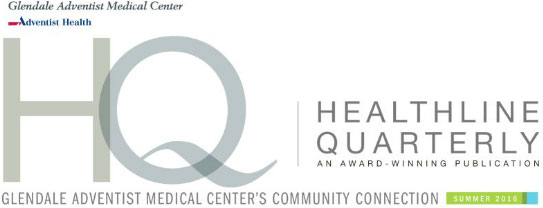WEAK IN THE KNEES?
What happens when you hurt your ACL and how we can heal it
“I heard it pop.” That’s how many people tell the tale about the day an ACL injury took them off the ski slope, football field, basketball court or soccer field. ✦ ACL stands for anterior cruciate ligament.
“The ACL is one of four important structures that stabilize the knee,” explains Michael Abdulian, MD, orthopedic surgeon and sports medicine specialist at Glendale Adventist Medical Center’s (GAMC) Orthopedic Institute. “It runs down the middle of the knee from the femur to the tibia and keeps the tibia—the shinbone—from sliding too far forward.” ACL injuries occur when your foot is planted on the ground but your body continues to move or twist. They usually occur during sports, and the majority are actually non-contact injuries. “The ACL often makes a popping sound when it tears,” Dr. Abdulian says. Pain, swelling, tenderness, inability to walk and loss of motion are other symptoms. After injury, the knee usually feels unstable.
WHAT CAUSES AN ACL INJURY?
According to the American Academy of Orthopaedic Surgeons (AAOS), you can injure your ACL in a number of ways, such as:
- Changing directions rapidly.
- Stopping suddenly.
- Falling backward as the lower leg moves forward.
- Slowing down while running.
- Landing incorrectly from a jump.
- Colliding with another player or object.
While ACL injuries are common in athletes, they can happen to anyone.
WHAT ARE MY OPTIONS?
“How an ACL injury is treated depends on the degree of injury and if there are other injured structures in the knee,” explains Dr. Abdulian. Care is usually tailored to each patient’s individual needs and injury. According to Dr. Abdulian, for some patients, braces and physical therapy may be all the treatment that is needed. In other cases, surgery is the best option to get patients back to sports. “In surgery, the ACL is usually rebuilt using another tendon taken from elsewhere in the body—such as from a hamstring or quadriceps,” he says. Another option is to use a donor graft to reconstruct the ligament. “It’s an arthroscopic procedure that uses very small incisions.” Whether treatment involves surgery or not, rehabilitation is crucial, Dr. Abdulian says. A structured, progressive physical therapy program can take several months, but it’s the best way to get you back in motion—and doing the sports and activities that you love.
If you think you may have injured your ACL, don’t wait—call the GAMC Orthopedic Institute at (818) 863-4446 for an appointment with one of our orthopedic surgeons! To learn more, visit AdventistHealth.org/Glendale/Ortho.
Read Full Publication Online: http://glendaleadventist.flippublication.com/Issue/550F4533-06F4-5AB7-F3BBAEB6BA5DE78A/Summer2016/

